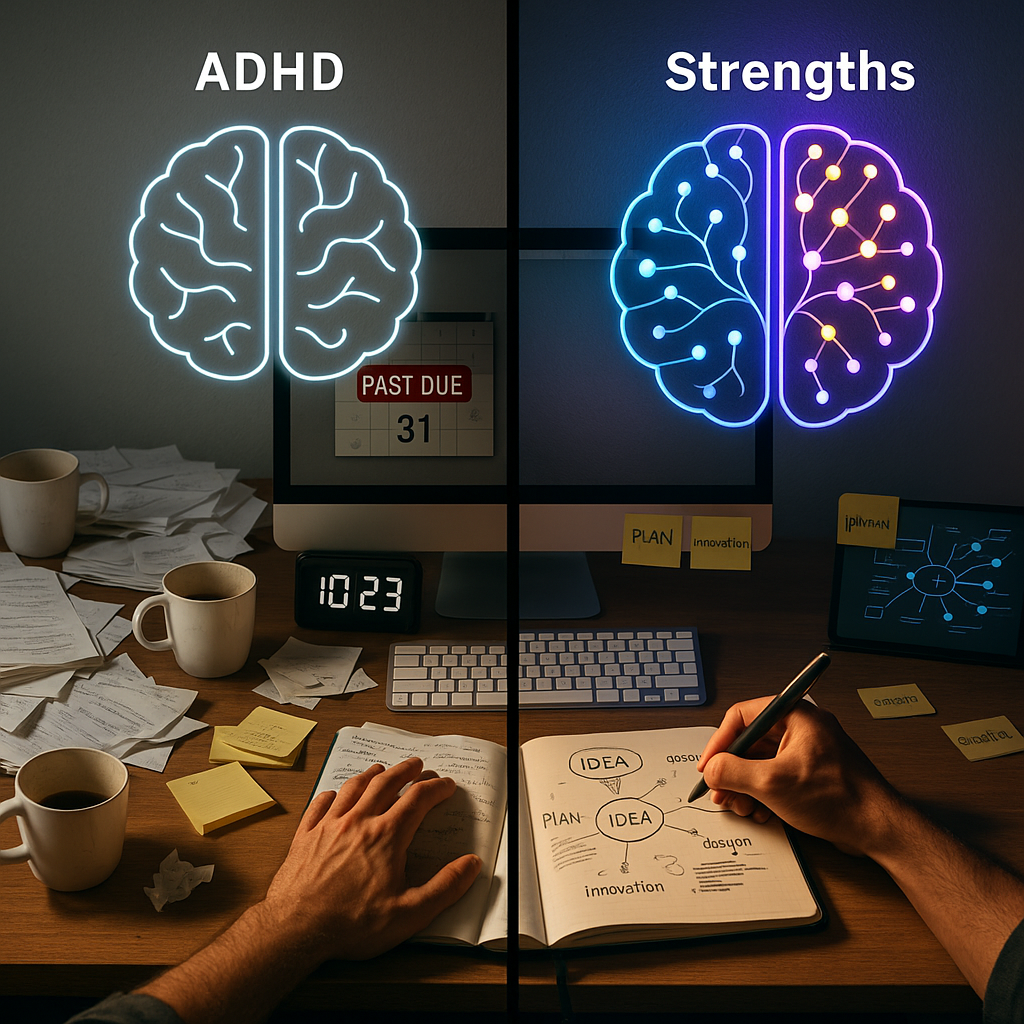Key Takeaways
- Adult ADHD remains widely misunderstood. Outdated myths and stereotypes persist, often overshadowing the real science and leaving many adults struggling with stigma, self-doubt, or even dismissing their own challenges. Here, we debunk the top misconceptions about adult ADHD, using research and relatable experiences to reveal the truth.
- ADHD does not simply disappear with age. Decades of research confirm that, for most individuals, ADHD continues into adulthood, often manifesting in new and unexpected ways.
- It is not just about hyperactivity or bouncing off the walls. In adults, ADHD more commonly appears as distractibility, restlessness, mood swings, and challenges with focus (far beyond the classic image of “hyperactivity.”)
- Intelligence does not shield you from struggles. Many highly intelligent adults with ADHD still face significant executive function challenges, despite their talents and capabilities.
- ADHD is not a moral failing or a lack of willpower. Robust neurological evidence shows ADHD arises from brain-based differences, not laziness or a flaw in character.
- Women and non-binary adults are significantly underdiagnosed. Stereotypes and diagnostic biases cause many adults (especially women and gender-diverse individuals) to be missed, misdiagnosed, or dismissed until much later in life.
- You cannot simply “grow out of it” or “try harder.” Research confirms that coping strategies alone are insufficient. Real understanding, self-compassion, and tailored support are essential for those with ADHD.
- Medication is not a shortcut or “easy way out.” Decades of scientific studies confirm that properly prescribed ADHD medications are safe and effective for the majority of adults.
- ADHD often comes bundled with invisible challenges. Co-occurring conditions, such as anxiety, depression, rejection sensitivity, and burnout, are common and can profoundly impact daily life.
- Success and ADHD are not mutually exclusive. Many high achievers, founders, and leaders credit their ADHD for fueling innovation and creative problem-solving, demonstrating that success and struggle can coexist.
- ADHD is not just an American or Western “trend.” Extensive global research shows that ADHD occurs worldwide, debunking the myth that it is a culture-specific diagnosis.
- While self-diagnosis is common and relatable stories can be validating, formal research and clinical evaluation are still critical for accurate diagnosis and accessing optimal support.
- Lived experience is just as valuable as research. The true picture of adult ADHD emerges when scientific findings and personal stories are considered together. ADHD is not a simple checklist; it’s a nuanced, very human experience.
Dispelling these myths can be transformative, providing validation and opening the door to understanding for adults with ADHD, as well as those who care for or work with them. Let’s explore the real facts and lived realities behind these common misconceptions, and uncover what it truly means to thrive with ADHD as an adult.
Introduction
Think adult ADHD is just “being easily distracted” or something you simply outgrow after childhood? Decades of rigorous research paint a very different picture. It features overlooked daily struggles, hidden reservoirs of strength, and a landscape filled with persistent myths that follow people well into adulthood.
Misinformation about adult ADHD is more than inconvenient. It affects everything from self-confidence to the accessibility of treatments and accommodations. Worn-out stereotypes can render legitimate challenges invisible, dismiss real science, and make millions doubt their lived reality. By clearing away these myths, we empower ourselves and others with genuine knowledge, practical strategies, and the affirmation that many adults desperately seek.
Let’s break down the twelve most persistent myths about adult ADHD, pairing each with solid scientific evidence and the real stories of adults living with the condition.
Understanding Adult ADHD: Myths vs. Research
Current research estimates that 4% to 5% of adults worldwide live with ADHD, yet widespread misconceptions still heavily influence how the condition is seen and treated. Over the past decade, scientific understanding has evolved dramatically, showing that ADHD is a complex neurodevelopmental condition with presentations that differ in significant ways from those seen in children.
The Evolution of ADHD Understanding
Today’s neuroscience reveals that ADHD includes differences in brain structure and function, particularly in regions responsible for executive functioning. Imaging studies show variations in prefrontal cortex activity and dopamine regulation. This deeper understanding breaks away from viewing ADHD as merely a childhood behavioral problem and places it firmly in the realm of lifelong neurodiversity.
Myth 1: “Adults Can’t Have ADHD. It’s a Kid’s Condition”
The idea that ADHD ends at adolescence is contradicted by overwhelming evidence. Research shows that 50% to 65% of children with ADHD continue to experience symptoms as adults. A landmark 2021 study published in the Journal of Clinical Psychiatry found many adults were first diagnosed after age 30, often after struggling for decades without support.
The Reality:
ADHD is a lifelong condition that evolves at each stage of life. Although physical hyperactivity may diminish with age, adults often experience:
- Persistent internal restlessness
- Heightened difficulty with time management and organization
- Unique challenges in sustaining careers and relationships
Myth 2: “ADHD is Just an Excuse for Laziness”
This damaging belief ignores clear-cut neurobiological evidence. The National Institutes of Health has demonstrated that ADHD brains show distinct differences in dopamine processing and executive function. As a result, adults with ADHD often exert tremendous effort, sometimes more than their neurotypical peers, to achieve similar results.
The Truth:
Adults with ADHD frequently adopt complex compensation strategies, which may include:
- Working extended hours to keep pace with deadlines
- Innovating creative solutions for routine obstacles
- Leveraging unique problem-solving skills in professional settings
Myth 3: “People with ADHD Can’t Be Successful”
Research tells a different story. According to the Harvard Business Review, many successful entrepreneurs, artists, and leaders openly speak about how ADHD empowers their creative thinking and risk-taking.
Success Stories and Statistics:
- Approximately 35% of entrepreneurs report significant ADHD traits
- CEOs of several Fortune 500 companies have discussed their ADHD experiences
- Many creative professionals cite their ADHD as a driving force in their innovation
Not only is success possible for adults with ADHD, but their neurodivergent strengths often become assets in fields that value creative, outside-the-box thinking.
Myth 4: “ADHD is the Same in Everyone”
Science is clear: ADHD is not one-size-fits-all. A comprehensive 2022 analysis documented multiple ADHD subtypes and presentations.
Key Research Findings:
- The three recognized presentations are: predominantly inattentive, predominantly hyperactive-impulsive, and combined type
- Symptom expression varies based on environment, available supports, and individual brain chemistry
- Gender differences and cultural expectations create vastly different diagnostic patterns
Understanding these differences helps debunk “cookie-cutter” thinking and paves the way for more personalized, effective care.
Myth 5: “ADHD is Just Poor Focus”
ADHD impacts far more than attention spans. It disrupts core executive functions, emotional self-regulation, and time perception.
Scientific Evidence Shows:
- Working memory differences affect how information is retained and used
- Difficulty accurately tracking time (often called “time blindness”) impacts planning and follow-through
- Emotional regulation challenges can manifest as mood swings or heightened sensitivity
These multidimensional effects mean ADHD is much more than merely “being distracted.”
Myth 6: “Medication is the Only Treatment”
Medication is an effective and scientifically validated option, but not the only one. Most adults benefit from a multimodal approach. A comprehensive review in The Lancet found that combining treatments delivers the best long-term outcomes.
Effective Treatment Approaches Include:
- Cognitive Behavioral Therapy (CBT) and coaching tailored to ADHD
- Environmental modifications and simple organizational systems
- Incorporating exercise, sleep, and diet adjustments for better brain function
- Smart use of technology, apps, and automation tools to scaffold daily routines
Industries such as healthcare, education, and even finance increasingly recognize the value of combining pharmaceutical and non-pharmaceutical interventions to better serve both neurodivergent professionals and clients.
Myth 7: “ADHD People Can’t Focus on Anything”
Neuroscience research reveals that many adults with ADHD experience “hyperfocus,” a state of intense absorption in tasks they find engaging or meaningful.
Understanding Hyperfocus:
- Hyperfocus can drive outstanding productivity in fields like coding, design, or research
- It reflects unique patterns of brain activation and dopamine processing
- Once managed effectively, hyperfocus can become a powerful asset rather than a liability
This trait is recognized across sectors such as technology, healthcare (medical research), marketing, and the creative arts as a potential source of competitive advantage.
Myth 8: “ADHD is Caused by Poor Parenting or Diet”
Decades of genetic and neuroscientific research have found that ADHD is most strongly influenced by hereditary and neurological factors. Twin studies place heritability at approximately 74%, making genetics a leading component.
Scientific Evidence:
- Multiple genes contribute to ADHD expression
- Brain structure differences routinely appear in imaging studies
- Environmental factors (such as parenting or diet) may affect severity, but do not cause ADHD
These findings are recognized by clinicians in medicine, education, and mental health worldwide.
Myth 9: “Adults with ADHD Are Just Making Excuses”
Concrete neurological differences underlie the challenges experienced by adults with ADHD. For example, a 2023 workplace study found ADHD-related difficulties cost individuals an average of $15,000 per year in lost productivity, impacting industries from tech and law to healthcare and education.
Impact Areas:
- Time management struggles can reduce work performance and career progression
- Executive function differences often require additional support for organization
- Working memory challenges can make task completion more complex
Recognizing these realities not only reduces stigma, but also prompts companies and organizations to offer better support and accommodations.
Myth 10: “ADHD People Are Less Intelligent”
Large-scale studies confirm there is no connection between ADHD and lower intelligence. In fact, many adults with ADHD show exceptional creative thinking, divergent problem-solving, and innovation.
Research Highlights:
- IQ distributions among those with and without ADHD are similar
- Unique thinking patterns often lead to novel solutions in business, law, and creative industries
- Diverse learning styles call for adapted educational and workplace strategies
These strengths are appreciated in industries requiring rapid adaptation and inventive approaches, such as entrepreneurship, marketing, education, and engineering.
Myth 11: “You Can’t Develop ADHD as an Adult”
Although ADHD is present from a young age, symptoms sometimes remain masked until adulthood. Stressful life transitions or increased demands can reveal previously managed challenges.
Understanding Adult Onset:
- Symptoms are often present from childhood, but environmental and support factors influence how they appear
- Major life changes (new jobs, parenthood, higher education) can unmask ADHD traits
- Support systems in place during youth can shield or compensate until adulthood demands increase
This is a crucial point in clinical, educational, and workplace assessment.
Myth 12: “ADHD is Overdiagnosed”
Contrary to media coverage, research indicates underdiagnosis is a bigger issue, especially among adults, women, and minorities. Detailed reviews show diagnostic procedures are generally thorough and evidence-based.
Statistical Evidence:
- Adult diagnosis rates consistently fall below actual prevalence, leading to many going unsupported
- Gender and cultural biases contribute to delayed or missed identification, especially outside of the traditional “hyperactive boy” stereotype
- Across healthcare, education, and social systems, more accurate screening and unbiased assessment practices are needed
Why Busting ADHD Myths Matters: Impact on Treatment and Support
Dispelling these myths goes beyond education. Research shows that persistent misconceptions cause delays of six to seven years in seeking diagnosis and treatment, resulting in compounded challenges throughout life.
The Cost of Misconceptions
When myths remain unchallenged, they directly contribute to:
- Delayed access to treatment and supportive services
- Increased workplace discrimination and penalization
- Greater levels of internalized shame, stigma, and isolation
- Reduced availability of academic and workplace accommodations
These challenges not only slow personal growth, but also cost businesses and communities the untapped potential of neurodivergent minds.
Conclusion
The latest research and real-life experiences have thoroughly debunked the outdated myths surrounding adult ADHD, illuminating the condition as a nuanced and lifelong neurodevelopmental difference. Far from being a childhood-only issue or a matter of willpower, ADHD is now understood as a diverse condition shaped by distinctive brain wiring, adaptive strengths, and varied life presentations. Adults with ADHD often struggle less with the neurobiology itself and more with societal misunderstanding, stigma, and inadequate support.
By shifting our collective mindset from judgment to empowerment, we clear the way for effective treatments, tailored accommodations, and a broader celebration of neurodiversity across industries and communities. For professionals, leaders, and organizations, the real opportunity is not just in dismantling misconceptions, but in building environments where misunderstood differences drive innovation, resilience, and sustainable success. As we look to the future, those who embrace a neurodiversity-affirming approach (valuing real science alongside lived experience) will shape workplaces, schools, and communities that thrive on collective brilliance, not conformity. The challenge ahead is clear: will you lean into understanding, or be left behind in a changing world that is finally recognizing the power of every mind?





Leave a Reply